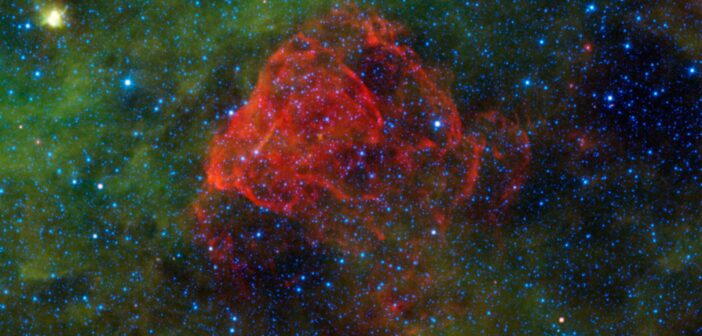Across the universe, charged particles are accelerated to nearly the speed of light, attaining energies of quadrillions of electronvolts or more. Within the Milky Way, supernovae have long been considered a likely source of these mind-bogglingly fast particles, called cosmic rays, but new research suggests that supernovae can only accelerate particles up to such high energies for a brief time.
Searching for Galactic PeVatrons
Sources of cosmic rays in the petaelectronvolt (PeV) range — that’s one quadrillion electronvolts, or the energy of a proton traveling at more than 99.9999999999% of the speed of light — are called PeVatrons. The hunt for PeVatrons in the Milky Way has closed in on supernovae, whose expanding shocks provide a way to accelerate particles up to high velocities. But whether supernova shocks can actually accelerate particles up to PeV energies is up for debate. Answering this question is key to understanding where particle acceleration happens in our universe.
Shocks, in expanding supernova remnants or elsewhere, are thought to accelerate particles through a process called diffusive shock acceleration. In this process, charged particles bounce back and forth across a shock as it moves, reflected by fluctuations in the magnetic field. The particles gain energy with each bounce until they escape the shock and zoom away. In the case of supernovae, it’s not yet clear if the magnetic field strength is high enough to hold on to particles until they reach PeV energies.
Setting a Particle Speed Limit

Spectra of protons accelerated by a shock moving into uniform material (top row) and material with a wind-like distribution (bottom row). Results are shown for the cases of diffusing (left column) and escaping (right column) particles driving the increase in the magnetic field. Click to enlarge. [Diesing 2023]
Diesing’s modeling accounted for the complex interactions between the shock, the particles being accelerated, and the magnetic field. As particles are accelerated, they play a role in shaping the shock itself: the motion of charged particles as they diffuse back and forth across the shock and finally escape it changes the magnetic field, producing fluctuations that boost the magnetic field strength. The increase in the magnetic field strength should allow the shock to hold on to particles longer, accelerating them to higher energies — but is it enough to get particles up to the PeV range?

Predicted maximum energy of accelerated cosmic rays as a function of the supernova remnant’s age. 1 PeV = 106 GeV. Click to enlarge. [Diesing 2023]
Unlikely Accelerators
Diesing’s calculations show that supernova remnants can only produce particles at PeV energies when the shock velocity is higher than 10,000 km/s or when the material into which the shock expands is dense. These high velocities are attainable by young supernova remnants, but not by the supernova remnants we know of in our galaxy, all of which are centuries old.
This suggests that a small number of supernovae can act as PeVatrons for a short time. To complicate the search for PeVatrons in our galaxy, Diesing found that even supernovae that are no longer producing PeV-energy cosmic rays can still generate high-energy gamma rays, which are often taken as evidence of a PeVatron.
Citation
“The Maximum Energy of Shock-Accelerated Cosmic Rays,” Rebecca Diesing 2023 ApJ 958 3. doi:10.3847/1538-4357/ad00b1

